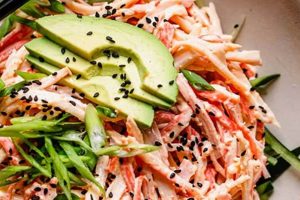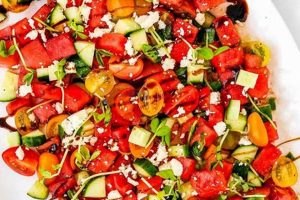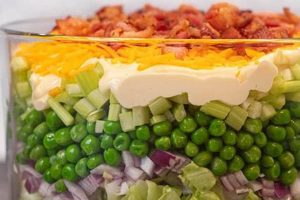Simple carrot salad variations typically involve shredded or grated carrots combined with a limited number of readily available ingredients. These might include sweeteners like honey or sugar, acidic components such as vinegar or lemon juice, and flavor enhancers like spices, herbs, nuts, or raisins. An example would be a grated carrot salad with lemon juice, olive oil, and a sprinkle of salt and pepper.
Quick and accessible preparations offer several advantages. They require minimal cooking skills and kitchen equipment, making them suitable for individuals with limited experience or time constraints. Such salads also frequently incorporate fresh, unprocessed ingredients, contributing to a nutritious and healthy diet. Historically, basic carrot salads likely originated as ways to preserve and enhance the flavor of carrots, especially during colder months when fresh produce was scarce. This tradition of simplicity contributes to the enduring popularity of these recipes today.
This foundation of simplicity allows for considerable culinary creativity. The following sections will explore a variety of readily achievable recipes, covering different flavor profiles and techniques for enhancing texture and presentation.
Tips for Simple Carrot Salads
Achieving optimal flavor and texture in uncomplicated carrot salads relies on attention to a few key details. These tips offer guidance for maximizing the potential of these readily prepared dishes.
Tip 1: Grate or shred carrots uniformly. Consistent size ensures even coating with dressings and contributes to a pleasing texture. A box grater or food processor offers the best results.
Tip 2: Balance sweetness and acidity. The interplay between sweet and acidic elements is crucial. Adjust proportions of ingredients like honey, sugar, vinegar, or citrus juice to achieve a harmonious flavor profile.
Tip 3: Incorporate textural variety. Nuts, seeds, raisins, or shredded coconut provide contrasting textures and enhance the overall sensory experience.
Tip 4: Enhance flavor with fresh herbs. Chopped cilantro, parsley, mint, or dill can elevate a simple salad with fresh, vibrant flavors.
Tip 5: Macerate carrots briefly for added flavor. Allowing the carrots to sit with the dressing for a short period, even 15 minutes, allows the flavors to meld and the carrots to soften slightly.
Tip 6: Consider adding spices. A pinch of ground cumin, coriander, ginger, or cinnamon can introduce warmth and complexity.
Tip 7: Adjust dressing consistency. Thicker dressings cling better to the carrots. A touch of olive oil or a small amount of mayonnaise can achieve this.
Implementing these strategies ensures a delicious and satisfying carrot salad experience, maximizing the flavor and texture achievable with minimal effort.
By focusing on these elements, even the simplest carrot salad can become a flavorful and nutritious addition to any meal.
1. Fresh Ingredients
The emphasis on fresh ingredients in simple carrot salads significantly impacts the resulting flavor, texture, and overall quality. Freshly harvested carrots offer a naturally sweet and crisp character often absent in older produce. This inherent sweetness reduces the need for excessive added sugars, promoting a healthier nutritional profile. Similarly, fresh herbs and spices contribute vibrant, nuanced flavors that dried alternatives struggle to replicate. For instance, freshly squeezed lemon juice provides a brighter, more pronounced acidity compared to bottled varieties, enhancing the overall balance of the salad. This reliance on fresh components aligns with the “easy” aspect of these recipes, as minimal processing or preparation is required.
Using fresh ingredients offers distinct advantages beyond flavor. The crisp texture of recently harvested carrots adds a satisfying crunch, while fresh herbs contribute a vibrant visual appeal. This difference is noticeable when comparing a salad made with fresh carrots and herbs to one using older carrots and dried seasonings. The former exhibits a lively, appealing appearance and a refreshing crunch, while the latter may appear dull and offer a less satisfying texture. From a practical perspective, this emphasis on freshness also encourages seasonal eating, promoting both variety and the consumption of produce at its peak flavor and nutritional value. Furthermore, the reduced reliance on processed ingredients and refined sugars aligns with healthier eating habits.
In summary, prioritizing fresh ingredients is paramount in achieving a truly successful simple carrot salad. The enhanced flavor, textural appeal, and nutritional value directly contribute to a more satisfying culinary experience. The inherent simplicity of these recipes further benefits from the minimal processing required for fresh components. Choosing fresh, high-quality ingredients ensures the realization of the full potential of these uncomplicated yet rewarding dishes.
2. Simple Techniques
The “easy” component of carrot salad recipes is inextricably linked to the employment of simple techniques. Minimal manipulation of ingredients preserves their natural flavors and textures while reducing preparation time. Grating, shredding, or chopping carrots are fundamental techniques requiring basic kitchen tools. Similarly, whisking together a simple dressing involves minimal effort. This accessibility broadens the appeal of these recipes, making them achievable for individuals with varying culinary skill levels. For example, a classic grated carrot salad requires only grating, whisking, and combining actions achievable even by novice cooks. This reliance on straightforward techniques contributes significantly to the ease and speed of preparation, a defining characteristic of these recipes.
The simplicity of techniques employed also impacts the overall outcome of the salad. Avoiding complex procedures allows the natural flavors of the core ingredients to shine. Overly complicated techniques can mask the sweetness of carrots or the brightness of a vinaigrette. Furthermore, simple techniques often require fewer ingredients, reducing the risk of flavor imbalances. Consider a lightly dressed shredded carrot salad with toasted nuts. The simple preparation allows the natural sweetness of the carrots, the crunch of the nuts, and the lightness of the dressing to harmonize. This focus on core flavors enhances the sensory experience and reinforces the inherent appeal of fresh, minimally processed foods.
In conclusion, the connection between simple techniques and easy carrot salad recipes is fundamental. Straightforward preparation methods reduce time investment, increase accessibility, and preserve the natural flavors of the ingredients. This correlation underscores the value of uncomplicated cooking, demonstrating that delicious and nutritious meals can be achieved without complex procedures or extensive culinary expertise. This principle empowers individuals to embrace home cooking and enjoy fresh, flavorful meals with minimal effort, ultimately promoting a healthier and more sustainable lifestyle.
3. Balanced Flavors
Balanced flavors are essential to successful simple carrot salads. The inherent sweetness of carrots necessitates the incorporation of contrasting elements to prevent the final dish from being cloying. Acidity, often from vinegar or citrus juice, provides the necessary counterpoint to sweetness. This interplay creates a dynamic flavor profile that engages the palate. Further complexity can be achieved by incorporating salty, savory, or spicy notes. For example, a salad featuring grated carrots, lemon juice, honey, and a pinch of cumin exhibits a balance of sweet, sour, and savory flavors. Without the acidic lemon juice, the sweetness of the carrot and honey would dominate, resulting in a less nuanced experience.
Achieving balanced flavors in these recipes does not require complex techniques or exotic ingredients. Often, a few readily accessible pantry staples suffice. The interplay of these simple elements creates a synergistic effect, elevating the overall flavor profile beyond the sum of its parts. Consider a basic carrot salad with olive oil, apple cider vinegar, salt, and pepper. The simplicity of these ingredients belies the complexity of the resulting flavor profile, demonstrating the power of balanced elements. Moreover, this simplicity reinforces the “easy” aspect of these recipes, emphasizing that culinary complexity need not require extensive effort or specialized ingredients.
The principle of balanced flavors in easy carrot salads highlights the importance of thoughtful ingredient selection and proportioning. While these recipes rely on simplicity, they also underscore the culinary impact of balanced flavors. This balance elevates simple ingredients, transforming them into something greater than the sum of their parts. This understanding empowers individuals to create flavorful, satisfying dishes with minimal effort, contributing to both healthier eating habits and a greater appreciation for the nuances of culinary balance. Furthermore, the ease of achieving this balance encourages experimentation and creativity within the simple framework of these accessible recipes.
4. Textural Variety
Textural variety plays a crucial role in elevating simple carrot salads from basic to engaging culinary experiences. The inherent texture of raw carrots, while refreshing, can become monotonous if not complemented by contrasting elements. Incorporating ingredients with different textures creates a more dynamic and satisfying sensory experience. This textural diversity can be achieved through various readily available additions, aligning with the “easy” aspect of these recipes. Toasted nuts, such as walnuts or almonds, introduce a satisfying crunch, while dried fruits like raisins or cranberries offer a chewy counterpoint. Seeds, such as sunflower or pumpkin, provide a subtle crispness, while shredded coconut adds a unique, slightly chewy texture. These additions not only diversify the mouthfeel but also often contribute complementary flavors, further enhancing the overall appeal.
Consider the difference between a simple grated carrot salad with only a vinaigrette and the same salad with the addition of toasted slivered almonds and chopped dried cranberries. The former, while refreshing, may lack textural complexity. The latter, however, offers a more engaging experience with the contrasting crunch of the almonds and the chewiness of the cranberries playing against the tender carrots. This contrast prevents textural fatigue and elevates the simple salad to a more satisfying dish. Furthermore, the incorporation of these textural elements does not complicate the preparation process, maintaining the ease and accessibility of the recipe. A handful of nuts or dried fruit tossed into the salad requires minimal effort but yields a significant improvement in the overall culinary experience.
Understanding the impact of textural variety in simple carrot salads allows for greater culinary creativity within the constraints of easy preparation. Recognizing the potential of readily available ingredients to introduce contrasting textures empowers individuals to elevate basic recipes without sacrificing simplicity. This awareness promotes a more thoughtful approach to ingredient selection, demonstrating that even uncomplicated dishes can offer complex and satisfying sensory experiences. The practical application of this understanding encourages culinary exploration and a deeper appreciation for the role of texture in enhancing enjoyment of food. This focus on textural variety ultimately elevates the perceived value of simple, healthy meals, making them more appealing and contributing to a more satisfying and balanced diet.
5. Quick Preparation
The “easy” designation for carrot salad recipes is significantly influenced by the speed and simplicity of preparation. “Quick preparation” is not merely a desirable attribute but a defining characteristic of these recipes. This characteristic stems from several factors, including the minimal processing required for core ingredients, the straightforward nature of assembly, and the limited reliance on specialized equipment or techniques. Cause and effect are directly linked: the inherent simplicity of the recipes allows for quick preparation, which, in turn, increases their accessibility and appeal, particularly for individuals with time constraints. A basic carrot salad, for example, can be prepared in minutes with readily available ingredients and basic kitchen tools. This speed and ease contribute directly to its classification as an “easy” recipe. This practicality expands the potential applications of these recipes, making them suitable for busy weeknight meals, last-minute additions to potlucks, or quick and healthy lunch options.
The importance of quick preparation as a component of “carrot salad recipes easy” extends beyond mere convenience. It contributes to the preservation of freshness and nutritional value. Minimal processing and short preparation times limit the exposure of ingredients to heat and air, thereby retaining vitamins and maximizing flavor. This aligns with the broader health-conscious trend of consuming fresh, minimally processed foods. Consider a salad composed of grated carrots, chopped apple, and a lemon vinaigrette. The quick preparation ensures that the ingredients retain their crispness and vibrant flavors, maximizing both the sensory experience and the nutritional benefits. This direct correlation between speed and quality reinforces the practical significance of quick preparation within this recipe category. Furthermore, the efficiency of these recipes makes them ideal for introducing novice cooks to the pleasures of preparing fresh, healthy meals, fostering a positive association with home cooking.
In summary, the connection between “quick preparation” and “carrot salad recipes easy” is fundamental. Speed and simplicity are not merely convenient attributes but integral components of the definition and appeal of these recipes. This connection reinforces the practical value of these recipes in various contexts, from busy weeknight meals to health-conscious dietary choices. Challenges may include maintaining textural variety and flavor complexity within the constraints of quick preparation, necessitating thoughtful ingredient selection and efficient techniques. However, the inherent simplicity of these recipes provides a versatile foundation for culinary creativity, allowing for diverse flavor profiles and textural combinations while maintaining the core principle of quick and easy preparation.
Frequently Asked Questions
This section addresses common inquiries regarding simple carrot salad recipes, offering practical guidance and clarifying potential uncertainties.
Question 1: How can one prevent grated carrots from becoming watery in a salad?
Salting grated carrots lightly and allowing them to sit for a short period (approximately 15 minutes) draws out excess moisture. This moisture should be patted away before combining the carrots with other ingredients and dressing.
Question 2: What are suitable alternatives to traditional sugar or honey in these recipes?
Maple syrup, agave nectar, or even finely chopped dates or raisins can serve as natural sweeteners, adding subtle flavor nuances in addition to sweetness.
Question 3: Can these salads be prepared in advance?
While preparation shortly before serving is generally recommended for optimal texture, these salads can be prepared a few hours in advance. Storing the carrots and dressing separately and combining them just before serving helps maintain crispness.
Question 4: How can one enhance the flavor profile of a basic carrot salad beyond the standard vinaigrette?
Incorporating toasted nuts, seeds, dried fruits, or fresh herbs can introduce complexity and depth. Spices such as cumin, coriander, or ginger can also enhance flavor profiles.
Question 5: What are effective methods for adjusting the consistency of a carrot salad dressing?
A touch of olive oil can thin a dressing, while a small amount of mayonnaise, Greek yogurt, or mashed avocado can create a creamier consistency. A teaspoon of Dijon mustard can also act as an emulsifier, helping to bind the dressing.
Question 6: How can carrot salads be adapted for different dietary needs, such as vegan or gluten-free diets?
Most basic carrot salads are naturally vegan and gluten-free. However, attention should be paid to specific ingredients, such as ensuring the use of maple syrup or agave nectar instead of honey for vegan variations, and avoiding cross-contamination with gluten-containing ingredients.
Addressing these common questions aims to provide a deeper understanding of simple carrot salad preparation techniques and encourage culinary exploration within this accessible recipe category. Successful outcomes depend on an understanding of core principles such as flavor balance, textural variety, and the importance of fresh ingredients.
The following section provides a selection of easy-to-follow recipes, illustrating the practical application of these principles and offering varied options for incorporating carrot salads into diverse meal plans.
Simple Carrot Salad Recipes
Exploration of straightforward carrot salad recipes reveals the effectiveness of minimal ingredients and techniques in creating nutritious and flavorful dishes. Emphasis on fresh, high-quality components, balanced flavor profiles incorporating sweetness, acidity, and optional savory or spicy notes, and the considered introduction of textural variety through nuts, seeds, or dried fruits significantly contributes to culinary appeal. Quick preparation, a defining characteristic of these recipes, enhances accessibility and preserves nutritional value. Addressing frequently asked questions regarding techniques and ingredient substitutions further empowers culinary experimentation within this accessible recipe category.
Carrot salad recipes exemplify the potential of simple cooking to deliver both flavor and nutritional benefits without demanding extensive time or specialized skills. This accessibility promotes broader adoption of healthy eating habits and encourages culinary exploration. Continued experimentation with flavor combinations and textural elements within this basic framework promises further evolution and enjoyment of this versatile dish.





